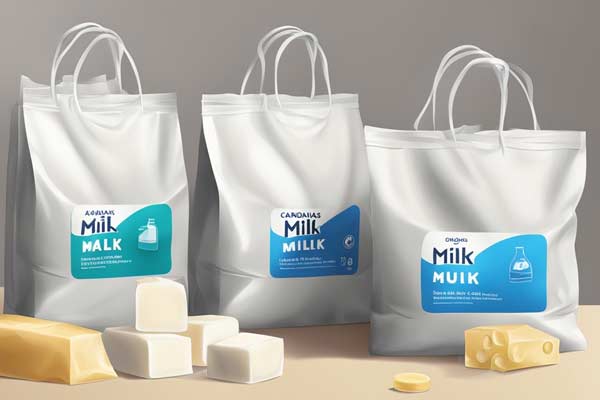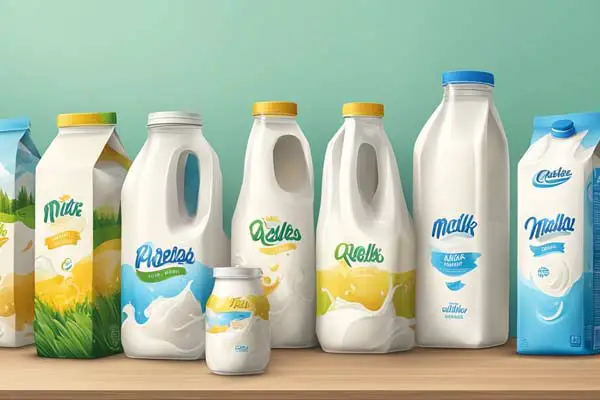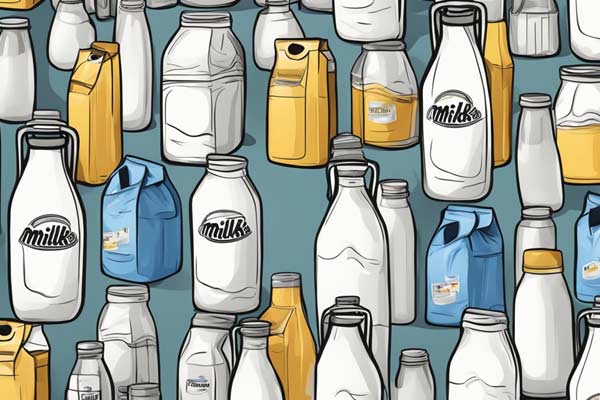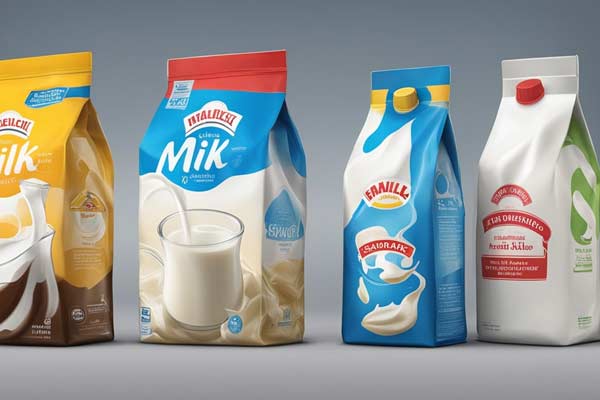Why Do Canadians Buy Milk in Bags: Exploring the Cultural and Practical Reasons
Canadians have a unique way of buying milk – in bags. This is a practice that has puzzled many people outside of Canada. So, why do Canadians purchase milk in bags?
The answer to why Canadians buy milk in bags can be attributed to a mix of factors, with cost being a significant influencer. Other vital considerations include convenience and environmental concerns.
Compared to other packaging options like cartons or bottles, bags are cheaper to produce and transport. This translates into lower prices for consumers. Additionally, bags take up less space in landfills, which also helps to reduce waste and costs.
One more factor contributing to the popularity of bagged milk among Canadians is its convenience. The bags are simple to store in the refrigerator and occupy less space than larger and bulkier bottles or cartons.
They are also easier to pour and handle, with less risk of spilling or splashing. Finally, bags are more lightweight than other packaging options, which makes them easier to transport from the store to the home.

History of Milk Packaging in Canada
In the early 20th century, milk was delivered to Canadian households in glass bottles by milkmen. These bottles were reused many times but were also heavy and fragile, making them expensive to transport and store.
In the 1960s, officials in Canada recognized that glass bottles were causing considerable waste and expense, and they began looking for alternatives.
Around the same time, Dupont introduced a new type of strong, lightweight, and flexible plastic. This plastic was perfect for milk packaging, and many Canadian dairies began using it to package their milk in jugs. However, these jugs were also heavy and bulky, making them difficult to transport and store.
In the late 1960s, Ontario dairies began experimenting with a new type of milk packaging: bags.
These bags were made of thin, flexible plastic and were designed to be used with a special pitcher to hold the bag and allow the milk to be poured without spilling. The bags were cheaper and lighter than jugs, making them easier to transport and store.
By the 1970s, milk bags had become a popular way to package milk in Canada. Most dairy farmers in Ontario used them, and their use was slowly spreading to other provinces.
Today, milk bags are an iconic part of Canadian culture, and many Canadians strongly believe they prefer bags, jugs, or glass bottles.
Although milk bags remain a favored choice in some areas of Canada, their popularity has dwindled in others. In the 1980s, regulations were implemented to limit the sale of milk to containers other than bags, ensuring that this packaging method persisted.
However, with Brian Mulroney’s government easing restrictions on metric measurements and the decreasing cost of hard plastic, the use of milk bags gradually declined in provinces such as Alberta and British Columbia.
The Shift to Bagged Milk
In the 1960s, Canadian dairies began experimenting with new packaging methods for milk. They wanted a way to reduce packaging costs and make milk easier to transport. The solution they came up with was bagged milk.
Bagged milk is now popular in many parts of Canada, particularly in Ontario and Quebec. It is sold in sets of three plastic bags, each containing one liter of milk. The bags are placed in a pitcher or jug, and the milk is poured out of a small hole in the corner of the bag.
One of the benefits of bagged milk is that it takes up less space than other packaging methods. This means more bags can be stacked and shipped in each delivery, reducing transportation costs.
Additionally, the bags are made of thinner plastic than the average milk jug, which means they use less plastic overall.
The shift to bagged milk was challenging. Consumers had to learn a new way of pouring milk, and some hesitated to switch from traditional cartons to plastic jugs. However, bagged milk’s cost savings and environmental benefits made it an attractive option for many Canadians.
It is worth noting that not all milk in Canada is sold in bags. Some dairies still use plastic jugs or cartons, particularly in regions where bagged milk is less popular. However, bagged milk remains a staple in many Canadian households, and it is a unique aspect of Canadian culture that sets it apart from other countries.
The Bagged Milk System
Canadians have been buying milk in bags since the 1970s, which is still popular. The bagged milk system sells milk in plastic bags that are typically one-quarter or 1.3 liters. These bags are placed inside a reusable pitcher or hard plastic milk jug.
The bagged milk system has some advantages over other milk packaging methods. For one, the bags occupy less space in landfills than traditional milk jugs.
Additionally, the bags are made of thinner plastic, which uses 75% less plastic than the average milk jug. This makes them easier to ship and store, reducing transportation costs and environmental impact.
The bags are also more convenient for some consumers. Once the bag is opened, it can be placed inside a reusable plastic holster that fits inside the pitcher.
This makes pouring milk easier and reduces the likelihood of spills. Some consumers also appreciate that they can buy multiple bags of milk at once and store them in their refrigerator without taking up too much space.
However, the bagged milk system does have some downsides. For one, the bags can be difficult to open, and pouring the milk without spilling can be challenging. The bags are less durable than traditional milk jugs and can tear or puncture easily.
Why Bagged Milk is Popular in Canada
Canadians have been buying milk in bags for over half a century, becoming a staple in many households. Here are some reasons why bagged milk is so popular in Canada:
Convenience
One key factor driving Canadians to choose bagged milk is its convenience. Unlike traditional milk containers such as jugs or cartons, milk bags occupy less fridge space and are simpler to manage and pour.
Additionally, their resealable feature allows users to open and close them multiple times without the risk of spills.
Environment
Bagged milk is also considered to be more environmentally friendly than other types of milk packaging.
The bags use less plastic than cartons or jugs, which means that they generate less waste. Additionally, the bags are recyclable, making them a more sustainable option.
Demand
In Canada, bagged milk has gained popularity due to its ability to satisfy consumers’ high demand. Given the significant milk consumption in Canada, using bags proves to be a cost-effective and efficient solution.
Moreover, these bags come in various sizes, allowing consumers to select the one that suits their preferences and requirements.
Plastic Milk Bags
Plastic milk bags are made from high-density polyethylene, a strong, durable, and lightweight plastic. The bags are designed to withstand the pressure of the milk and are less likely to break or leak. The plastic in the bags is also food-grade and safe for storing milk.
Habitual
Many Canadians have developed a tradition of purchasing milk in bags, a habit passed down through generations that holds significant importance in Canadian culture.
Many Canadians prefer the taste of milk from bags; they feel it is a more authentic and traditional way to consume milk.
Dairy Industry
The dairy industry in Canada has also played a role in the popularity of bagged milk. The industry has invested in technology that makes producing and packaging milk in bags easier.
One such technology is the Kankomat, which fills and seals milk bags. The Kankomat has made it possible for dairy farmers to produce and package milk more efficiently and cost-effectively.

Bagged Milk in Other Countries
While bagged milk is common in Canada, it is less prevalent in other countries. In the United States, milk is usually sold in jugs or cartons, with bagged milk being a rarity.
However, some states like Wisconsin, Minnesota, and Iowa have seen a recent surge in the popularity of bagged milk.
South Africa is another country where bagged milk is widely available. It is sold in bags of various sizes, ranging from 1 liter to 3 liters.
Milk is often sold in plastic bags in India, but it is less common than in Canada. The bags are tied or sealed with a rubber band to prevent spillage.
China, Russia, and Hungary also have bagged milk available, but it is less popular than other forms of packaging. In Argentina and Uruguay, bagged milk is sold in some supermarkets but has yet to be widely known.
In Israel, bagged milk is sold in some stores, but other forms of packaging are rare. In the United Kingdom, milk is usually sold in plastic bottles, while in Iran, milk is sold in glass bottles.
Colombia is another country where bagged milk is available, but it is less popular than other forms of packaging. Milk is usually sold in plastic bottles or cartons.
Bagged Milk vs Other Packaging Methods
When it comes to packaging milk, there are several options available. These include plastic pouches, hard plastic, resealable cartons, tetra paks, and paper cartons. However, in Canada, bagged milk is the most popular option.
One of the main advantages of bagged milk is that it is cost-effective. It is cheaper to produce and transport than glass bottles, which were the standard in the past. This is because bagged milk takes up less space and is lighter than other packaging methods.
Another advantage of bagged milk is that it is resealable. This means that consumers can use as much milk as they need and then reseal the bag to keep the remaining milk fresh. This is impossible with milk cartons, which must be finished once opened.
In terms of recycling, bagged milk is a good option. The bags are made from recyclable plastic and take up less landfill space than other packaging methods.
However, it is essential to note that not all municipalities accept bagged milk for recycling. Consumers should check with their local recycling program to see if bagged milk is accepted.
While bagged milk is a popular option in Canada, it has drawbacks. One of the main criticisms of bagged milk is that it is less energy-efficient than other packaging methods. The bags must be transported in larger quantities to compensate for their smaller size.

The Environmental Impact of Bagged Milk
One of the main reasons Canadian milk is packaged in bags is that it is more environmentally friendly than other forms of milk packaging.
The plastic film pouches used for bagged milk take up less space in transit, which means more bags can be stacked and shipped in each delivery, reducing transportation costs.
This also means less energy is required to transport the milk to stores, resulting in a lower carbon footprint.
Additionally, bagged milk generates less packaging waste than other forms of milk packaging.
While some argue that bagged milk is less easily recyclable than other forms of milk packaging, it is essential to note that many municipalities in Canada have recycling programs that accept plastic film pouches. These programs ensure that the bags are properly recycled and not end up in landfills.

Bagged Milk in the Future
As many Canadian provinces look to reduce plastic waste, milk bags are a better option than traditional jugs or cartons.
For example, Prince Edward Island has already banned plastic shopping bags, and British Columbia, Nova Scotia, Newfoundland, and Quebec are considering similar measures.
Unlike plastic jugs, milk bags use 75% less plastic and can be washed and reused for various purposes.
However, there are some challenges. For example, milk bags are less common in Alberta than in other provinces. This is because the Western Dairy Council, representing dairy farmers and processors in Alberta, has yet to find any processors willing to package milk in bags.
Additionally, milk bags are not included, while the deposit or recycling system for laminated and coated paper containers has been established in many provinces. Therefore, the bags are often thrown away instead of being recycled.
Additionally, the milk industry faced high costs when considering the alternatives of updating assembly lines or swapping out bulky glass bottles.
This prompted the introduction of milk bags as a cost-effective solution, as they are more affordable to manufacture and transport than glass bottles.







